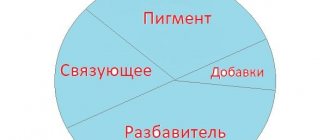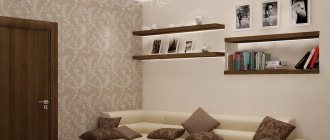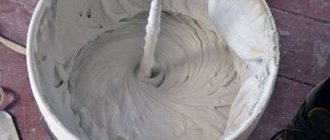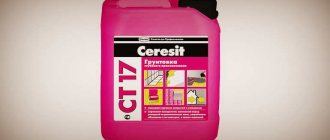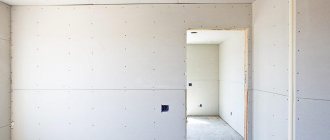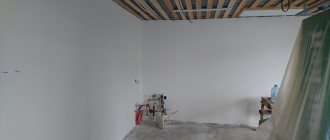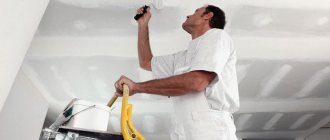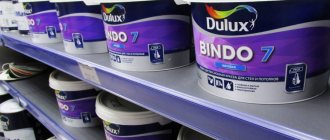Completion of repairs and most finishing and restoration work are rarely accomplished without the use of putty. The choice of this material for leveling various surfaces is complicated by the variety of types and the range presented in each category. The growing popularity of polymer compounds also forces a beginner in finishing work to decide whether latex putty or acrylic putty is better, which is better for a particular surface, which one is universal, and which one is cheaper.
Classification of putties
The entire variety of leveling compounds, according to the degree of working readiness, is divided into dry mixtures, which require the addition of water and mixing before use, and ready-to-use materials. From the stage at which they are used, a distinction is made between starting putty - for preparatory (rough) leveling and finishing putty - for fine (final) processing of the base surface before painting.
Working with the starting mixture
Decorative putty can be included in a separate category.
The use of finishing polymer mixtures for surface decoration
For your information! The purchase of a dry powder mixture is justified by the possibility of dosed preparation of the working composition with a viscosity convenient at this stage of work. The dry mixture is also convenient for transportation and storage, and has an extended shelf life.
Gypsum is the most popular putty for interior finishing work
. The main classification criterion is the used version of the basic binder component. According to him, there are the following types of putty:
- Cement based. Inexpensive compositions, not afraid of frost and humidity, universal (for interior and facade work), durable. To obtain certain characteristics, in addition to cement, other binders are added. Suitable for leveling significant differences (up to 15 mm). The disadvantage is the coarse grain size and the time it takes for the mixture to set.
- Plaster. Eco-friendly, “breathable” and economical finely dispersed mixtures for interior decoration. The applied composition sets quickly, is easy to sand, and has good adhesion to many materials. Among the disadvantages, we note the low resistance to mechanical stress and the need for rapid production of the prepared composition.
- Polymer putty on an acrylic or latex basis. This class will be discussed in more detail below.
- Adhesive, consisting of glue (up to 10% of the mass), chalk and drying oil. Elastic, easy to apply, sands well. Used for internal preparation of surfaces for painting.
- Oil, consisting of chalk, drying oil and an auxiliary composition (drier) for quick drying of the putty. Features of the mixture: elasticity, moisture and frost resistance, not afraid of ultraviolet radiation, compatibility with many materials (including wood), versatility.
Oil compositions are indispensable for mechanized leveling of large surfaces
Which putty is better - acrylic, gypsum or latex?
Some craftsmen do not know which material to choose - acrylic or cheaper, gypsum. To make it easier to make a choice, let’s consider the disadvantages and advantages of acrylic putty over gypsum putty:
- the cost of acrylic material significantly exceeds the price of gypsum putty;
- the acrylic composition has high moisture resistance and elasticity, which cannot be said about gypsum, which is not able to withstand exposure to moisture;
- gypsum material can be applied to the walls in a thicker layer than acrylic, but it will look much rougher. Acrylic putty should be applied in a very thin layer, resulting in a perfectly smooth and even surface.
Choosing the type of putty
For many, the question is also difficult: which putty is better: latex or acrylic? If we compare these two materials, the latex composition creates more durable surface protection than acrylic. It can be used as a coating for any and all surfaces. However, latex putty is very expensive, so it is recommended for use on external walls.
If you don’t know what is best for you: acrylic or latex putty, be guided by the purpose for which you need the finishing material. That is, if it is necessary to level the outer bases, give preference to a latex composition, and it is better to treat the internal surfaces with an acrylic composition.
Acrylic putty
A type of polymer mixture whose binder base is acrylic. Release form: ready-to-use paste-like composition in a factory-sealed container.
Basic properties
General distinctive properties of all compounds in this group:
- Excellent adhesion to various substrates.
- Tolerance (without destruction or loss of original properties) of critical temperatures, their sharp fluctuations, ultraviolet radiation, and high humidity.
- Environmentally friendly.
- Elasticity.
- Durability.
- No shrinkage during curing and drying.
- Availability of thermal insulation qualities.
Disadvantages and advantages over gypsum
When compared with gypsum putties, it is worth highlighting the following advantages:
- Durability and strength of the resulting coating, resistance to mechanical damage.
- Water resistance and resistance to fungal attack expands the range of application - facade surfaces, bathrooms, steam rooms, kitchens and other rooms with high humidity.
- When temperature changes, the coating does not crack or crumble, as is the case with gypsum compositions.
Let's add to the cons:
- high price;
- almost no vapor permeability, thanks to which the gypsum finish regulates and maintains a comfortable level of humidity in the room;
- the need to treat the surface in several thin layers, where one pass is made with gypsum;
- Despite the lack of toxicity and safety for humans, acrylic putty still contains artificial components.
Sample packaging of ready-to-use acrylic putty
Subtleties of use
If you pay attention to the following points, the workflow will be simplified and the results will not disappoint.
- When leveling ceilings, select a denser mixture.
- To work with walls, it is advisable to purchase water-dispersion compounds.
- It is better to carry out work on façade surfaces in warm but cloudy weather. In hot weather, the walls are moistened with a sprayer.
- The second layer is applied thinner than the previous one.
- For application to wood or metal, in order to protect these materials from destruction, water-repellent putty is used.
Application Tips
Here are some useful recommendations from practitioners:
- As the ambient temperature decreases, the elasticity of the working mixture decreases. This feature must be taken into account.
- When working, the putty must be stirred from time to time.
- For multi-layer application, a total thickness of 10 mm is allowed. Each layer must dry completely, then it is sanded and primed.
- You should not hesitate with the acrylic composition; it hardens quickly after application.
- To level metal surfaces, it is advisable to select the putty to match the base.
- The finishing layer on wood is carried out along the grain and as smooth as possible, because it is usually not sanded.
Similarities between latex and acrylic putties
- Both are mixtures of polymer chemicals that give them the properties they need in construction.
- They are used for finishing work on puttying surfaces, which involve leveling, filling small cracks and shallow potholes.
- Used for painting walls or wallpapering.
- Suitable for indoor work.
- Easy to use. Even a beginner can quickly master the principles of working with them.
- They have plasticity and good adhesion to the working surface. Durable.
- They do not shrink, so if used correctly they will not crack after drying.
- They often have antiseptic components that reliably protect against the formation of pathogenic fungi in the premises.
- They are produced ready for use in plastic containers of various weights for the convenience of the buyer.
- Without smell.
- Complies with environmental standards.
Latex putty
Latex mixtures are produced on a rubber base. Both ready-to-use and dry formulations are available for sale.
Basic properties
The main characteristics have something in common with acrylic compositions. But the fact that latex is made on the basis of natural or synthetic rubbers (that is, it can be considered rubber) makes the putty material more elastic, durable, resistant to abrasion and unwanted mechanical stress.
Disadvantages and advantages over gypsum
The comparative analysis of acrylic with gypsum given above can be applied to all polymer putties. True, it is worth adding superlatives to latex compositions in some characteristics. So, they are more durable, more wear-resistant, and more elastic. At the same time, they are more expensive and more “non-breathable”, since they practically do not allow moisture vapor to pass through.
An example of factory packaging of dry latex putty
Subtleties of use
Characteristic features of using latex putty:
- Before use, the bucket with the finished mixture must be kept at the work site for at least 2-4 hours to equalize the temperature.
- After application and drying, the latex layer cannot be sanded using abrasives or mesh. Even before hardening, remove all excess and eliminate defects with a slightly damp soft sponge.
- For exterior finishing, purchase a composition with the appropriate mark on the packaging, since the other options are intended for interior work.
- It is not recommended to exceed the layer thickness. The maximum value is 3 mm.
Application Tips
Tips from the masters will help you cope with the finishing without mistakes:
- The composition easily releases moisture, this is true even for a pre-primed surface. Therefore, it is advisable to moisten the base, and in hot weather this must be done.
- First, using a narrow spatula, fill deeper cracks and other defects. Then a thin leveling layer is applied with a wide tool.
- If you purchased a bucket with a large volume of mixture, then you will need a small container for work so that the entire solution does not dry out.
Latex putty
An innovative type of putty that is gaining popularity among amateurs and professionals. What distinguishes it from other types is the presence of a binding component - latex . The composition also includes modifying components, antiseptics, plasticizers, water and other fillers. This is an environmentally friendly material that is odorless, practical and easy to use.
It is used:
- For sealing seams in plasterboard structures.
- To eliminate small cracks, irregularities in walls and ceilings with a depth of no more than 2 mm.
- For finishing puttying of walls.
- To give surfaces a specific color.
This type of putty is popular due to its properties:
- Lightweight and easy to apply.
- Excellent adhesion to drywall, concrete, wood.
- Plastic.
- Full contact with the surface, fills all voids.
- Doesn't leave bubbles on the wall.
- Resistant to temperature changes.
- Doesn't crumble or peel off.
It has a high price . It cannot be stored at temperatures below 0℃, as this will lead to the loss of its properties. Latex putty is not used on metal surfaces. Used for interior work. It is released in ready-made form. Packaged in plastic containers of various weights. It can be white or have the color already needed for the interior, which eliminates the need to paint the walls or ceiling.
Main differences
Both putties from the polymer class are very similar in many characteristics and properties. But there are also significant differences that should not be forgotten and must be taken into account when selecting a working mixture.
Study the characteristics and features of the putty before use
Thus, latex putties may have higher viscosity and will require a certain experience of the performer when applying. They allow the application of ultra-thin coatings without any loss or reduction in the quality of the material. When latex hardens, it forms a surface film that does not absorb paint, which helps to significantly reduce paint consumption.
When professionally applied, a thin layer of material can replace paint and varnish composition. After freezing, the finished working mixture loses its properties and becomes unsuitable for use. Acrylic mixtures are cheaper, they are more often used for facade and other exterior decoration. The applied coating has greater vapor permeability. Unlike latex analogues, the material is recommended for working with metal surfaces.
Material properties
If we talk about the composition, it includes various plasticizers, antiseptics, binders and hardeners. The connecting link is the polymer component, thanks to which the use of latex putty allows you to protect walls from high humidity due to the formation of an elastic layer, which is durable and easy to process (see also the article “Materials for finishing ceilings - a huge selection for every taste”).
The main advantages can be considered the following factors:
- With this composition you can apply the thinnest layers, even if they are thinner than a millimeter, the coating will be reliable and durable. Therefore, if you are faced with the choice of latex or acrylic putty, and want to cover the walls with the thinnest layer, then the choice is obvious. Acrylic cannot be applied in a thin layer without losing its strength properties.
- Wide choice of colors. You will avoid unnecessary costs, time and money on purchasing paint and coloring, since you can purchase a latex composition of the desired color. In fact, this is a very big advantage that no other type of mixture can provide.
In the photo: this group of materials gives the surface the desired color
- The material is very convenient to work with - the mixture is sold ready-made, so it is impossible to make a mistake when diluting and creating the wrong consistency. Simply open the bucket and get to work. The elasticity of the composition simplifies its application, which is very important when doing DIY work.
Different packaging of the material will help you purchase the right amount, which will save significant money.
- Another very important property is the highest adhesion to almost any substrate. The composition works on the principle of liquid rubber - it fills all cavities and irregularities and adheres tightly to the surface.
- When hardened, the putty forms a film that does not crack or crumble, which distinguishes it favorably from acrylic and cement compositions. You do not need to be afraid that in places where the layer is thin, cracks will form and the coating will crumble.
This type of product also has some disadvantages, but they are few, which once again indicates high quality:
- The biggest drawback is the price. But if you take into account such factors as complete readiness for use immediately after purchase, ease of use even for inexperienced specialists and ready-made color, then it becomes clear that the cost is completely justified.
- And one more important factor: if the composition freezes during storage, its properties deteriorate significantly. You are unlikely to be able to work with such a mixture, so it is better to check the production date when purchasing and pay attention to the conditions in which the products are stored; in a cold pavilion, as a rule, such goods deteriorate.
Recommendations for selection
Purchasing the required composition is a very important part of the repair work. In addition to the main characteristics, pay attention to the following points:
- You should not purchase putty that is older than a year.
- For beginners, it is better to buy ready-to-use formulations.
- Consider the place of production. The closer the manufacturer is, the better the characteristics of the product are preserved.
- The universal composition can be used to apply the starting layer and finishing coat.
- In winter, buy ready-made mixtures in closed and heated retail outlets.
- For facades, mixtures are selected that indicate frost resistance on the label.
- Do not forget that acrylic mixtures with a wood texture are specially produced for wood.
- For facades, it is more economical to buy working material in large packages.
It cannot be stated unequivocally that some kind of putty - latex or acrylic - is certainly considered the best option for leveling surfaces. Each composition has features, advantages and limitations. They should be taken into account when choosing, and also pay attention to the presence in mixtures of additives and components responsible for certain properties. Any putty mixtures are in demand, and a professional will choose the most suitable option for a specific object, taking into account many nuances.
Tips and recommendations for use
Depending on the scope of application, application tips are formed. For example, you need to clearly know that water-dispersion putty cannot be used for ceilings. It exists only to protect against moisture. The same rule applies to other species. Depending on the type, which is determined by the scope of application, it is necessary to use the solution for its intended purpose. To cover surface defects, a starting solution is mainly used.
The application process consists of applying putty with a maximum permissible layer of 3 mm. If there are cracks during work, it is advisable to treat them with plaster. There are 2 application tools:
- spray gun;
- metal spatula.
The spray gun is used when diluting acrylic plaster with a solution, bringing it to a more liquid state. This type of tool is acceptable in the case of finishing. The starting material is applied with an iron spatula. Plasterboard ceilings are also applied to putty areas to level the surface. If the ceiling is uneven, it will be difficult to apply this material.
Important. The putty should be applied exclusively in above-zero temperatures, and choose the time so that there is no heat either. Permissible temperature is from 12 to 30 degrees Celsius. If these requirements are not met, the quality of the application decreases and there is a possibility of destruction.

